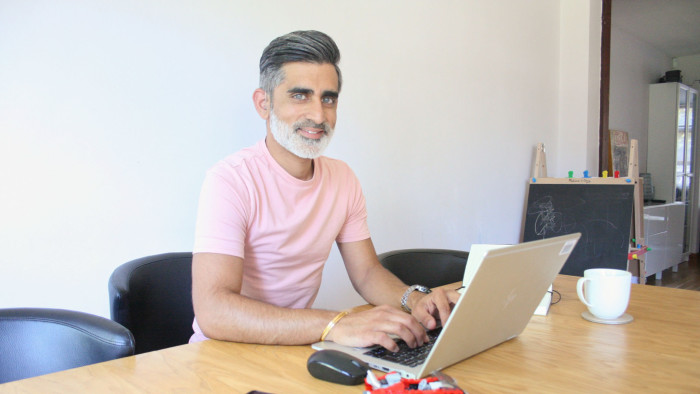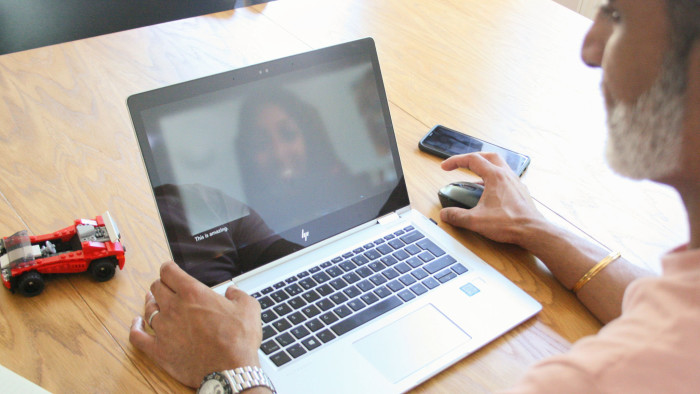How the lessons of lockdown will help disabled people at work

Roula Khalaf, Editor of the FT, selects her favourite stories in this weekly newsletter.
Before the coronavirus lockdown, Ganeev Chadha, who has profound hearing loss, had barely used a video conferencing app.
On his first day of working from home, he was on a video call where one participant’s WiFi connection was so poor that “I couldn’t see his face to lip-read or register his body language. It was impossible for me to work out what he was saying.”
As a commercial performance manager at professional services firm EY, Mr Chadha spends a good deal of time communicating with colleagues and clients. On the rare pre-lockdown occasions that video conferences replaced face-to-face meetings, he would connect only to the audio and respond with the help of a palantypist, a specialist in converting speech to text.
Within a week of home working, however, “I discovered a live captioning plug-in that I could use while on a call, and my ability to work improved dramatically.”
Mr Chadha’s transition to working from home was relatively smooth. He attributes this largely to the support fostered among colleagues by the EY network he leads of staff with hearing loss. In this, he knows he is fortunate.

In a recent survey of hard-of-hearing employees by UK charity Action on Hearing Loss, 42 per cent said they had not approached their employer for help at work. This reluctance is common among people with disabilities of various kinds, says James Taylor, head of strategy at disability equality charity Scope. “People we speak to often fear being perceived as a burden, which creates a barrier to effectively communicating their needs with their employer,” he says.
Many people turn to external organisations for help. Martin O’Kane, who leads the Royal National Institute of Blind People (RNIB) employment service, says his helpline team has received an influx of calls since lockdown. The most common requests are for help acquiring equipment such as large-screen monitors or keyboards, and for assistance installing magnifying and screen-reading software, such as Jaws (job access with speech) at home.
“Where it’s a quick issue with some software, we just liaise with an employee,” says Mr O’Kane. “But we sometimes need to step in and make sure the employer is supportive of their needs.”
“There’s no one-size-fits-all solution”, says Ghazi AbuYounis, a project finance associate at law firm Allen & Overy, who has a visual impairment. What works for one professional will not necessarily work for another with a comparable disability, he adds.
Mr AbuYounis recently took part in a trial of a plug-in called Define. “Because I zoom in a lot on my computer when reviewing documents, it can make scrolling up and down difficult,” he says. The plug-in let him divide the screen to check parts of a document without losing his place. “I hadn’t realised how inefficient I was until I tried something that made it so much easier.”
If employees are reluctant to open up to colleagues about their disability, it can help to have a mentor with similar needs. At EY, Mr Chadha offered colleagues practice video calls. “Once they’d tried it with me, most were much more comfortable,” he says.
The transition to working from home is often easiest for employees supported by teams already familiar with their requirements. Lloyds Bank was able to respond quickly to employees’ special equipment needs in March thanks to an internal forum set up by its HR department.
For Mr AbuYounis at Allen & Overy, telephone calls with a dedicated contact from the firm’s IT section made for quick home installation of software.
“People are frightened of disability because they think it’s going to be incredibly expensive for all the adjustments,” says Jane Hatton, founder and chief executive of recruiter Evenbreak. “But in fact they’re simple and cheap.” Her staff of 12, each with a different disability, worked remotely before the lockdown.
“We’d discovered the accessibility features of Zoom and Microsoft Teams long ago,” says Ms Hatton. “The technology is there already — it’s just a question of using it in a way that’s inclusive.”
She says Twitter chief executive Jack Dorsey’s email this month telling employees they could work from home “forever”outlined the kind of inclusive and flexible model advocated by Evenbreak since it started in 2011.
Editor’s note

The Financial Times is making key coronavirus coverage free to read to help everyone stay informed.
“The idea of a nine to five ‘in-the-office’ model is antiquated now,” says Ms Hatton. Two Evenbreak employees have ME and often need time out during the day but use flexi hours. “In nine years, they’ve never taken a sick day. As long as employees get their work done, it doesn’t matter where or when,” she adds.
A YouGov poll for Scope last year found that more than 1m people living with a disability in the UK were able and willing to work but unable to find employment.
About 15 per cent of the global population has some form of disability, says the World Health Organization, of whom 2-4 per cent “experience significant difficulties in functioning”. This amounts to both a significant untapped human resource and a substantial market. People with disabilities have $8tn of annual disposable income globally, according to Canadian research organisation Return on Disability.
“To be able to serve this market of disability, you need [people with disabilities] in your business,” says Caroline Casey, founder of The Valuable 500, a global initiative campaigning to put the inclusion of disabled people in business on the agendas of large companies at board level. She has seen an increase in companies signing up and committing to be one of 500 leaders in the field.
“The business system that we were told for so long could not adapt is now embracing flexible and agile working [during the pandemic],” Ms Casey says. “The difference [now] is an intention and a desire to change.”
Having adapted the way we work so dramatically and quickly, she adds, “why not empower everyone”, including disabled people, to contribute in the world of work. “There are no more excuses.”
Comments